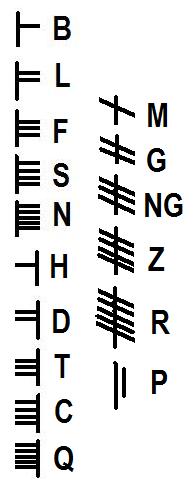Ogham or Ogam, pronounced “o’m” or “oem”, is an alphabet from the 4th century used to write the old Irish language. Ogham is found engraved on stones. There are only 382 relics found with such inscriptions, most of them in Ireland, the rest in Scotland, Wales, England and on the Isle of Man.
Divine inscriptions
The word “Ogham” derives from the Irish god Ogma, who is attributed with the creation of the alphabet. He is a rather important deity in the Irish mythology, being third god of the Pantheon. His main attribute is the sky in the darkness, however he is also praised for his eloquence and poetry.
The Ogham is composed of 25 letters, read from bottom to top when engraved or from left to right when written. Originally, it was composed of only 20 characters (feda), which are themselves divided in four groups of five. Five extra characters were later added for manuscripts. Those are called forfeda. Below is the depiction of each group of feda and how Ogham are written.
Sticks on stones
How is Ogham written? Following a vertical line, horizontal and diagonal strokes are engraved on each sides. The characters can be identified by the number of strokes and their orientations that are engraved along. They are often mistaken with runes, which were the Germanic alphabet. Albeit similar, they have different geographical origins.
The origins of this alphabet are obscure. While many theories can be read, two strong schools of thought came with an explanation.

The first one is that Ogham was invented by druids as a cryptic alphabet that was not to be understood by those using the Latin alphabet. In this context, it would have been a code used for political reasons against the Roman Empire invading Great Britain and Ireland.
The second possible explanation is that Ogham was invented by the first Christian communities in Ireland to transcribe sounds that seemed to be too complicated and foreign to be written with the Latin alphabet. The Irish language sounds indeed quite different from Roman languages.
Unfortunately, little is known about Ogham. The lack of information renders it all the more mysterious… like an Irish legend!
Right side/downward strokes
1. B beith
2. L luis
3. F fearn
4. S saille
5. N nuin
Left side/upward strokes
1. H úath
2. D duir
3. T tinne
4. C coll
5. Q ceirt
Across/pendicular strokes
1. M muin
2. G gort
3. NG gétal
4. Z straif
5. R ruis
Across/straight strokes
1. A ailm
2. O onn
3. U úr
4. E edad
5. I idad